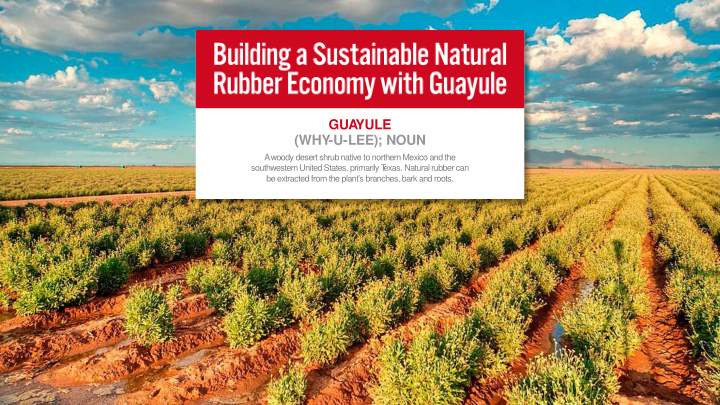



GUA YULE (WHY -U-LEE); NOUN A woody desert shrub native to northern Mexico and the southwestern United States, primarily T exas. Natural rubber can be extracted from the plant’s branches, bark and roots.
The Case for Guayule - The Rubber-Centric View • 2015 Natural Rubber Production Global = 12,300,000 MT • Tire Industry – Raw Material Use Asia-Pacific = 11,300,000 MT Natural Textile: 3% Rubber: 28% Chemical: 5% US = 0 Production by Region Steel: 15% /1000ha % Total Production Asia 8,747 93% Africa 482 5% S. America 180 2% Synthetic TOTAL 9,704 Rubber: 23% Filler: 26% • 2015 Natural Rubber Consumption US = 1,700,000 MT ~ 70% used for tires
Overview: Natural Rubber Today 500% fluctuation in 5-years 100% increase in 10-months • Labor Rates • Competitive Crops • Supply-Demand Balance • Speculation
Natural Rubber – The Situation The single most important raw material for tire manufacturing is: • Biologically single sourced A single species ( Hevea Brasiliensis ) supplies 100% of NR Clonal mono-cultures Disease issues Biodiversity • Geographically concentrated 93% of global supply from SE Asia Rapidly increasing labor costs Competition with low-labor alternative crops (palm oil) Climate change risk Geo-Political issues / Political instability Supply-demand imbalance as China/India demand grows • A Market Traded commodity subject to speculation and price-volatility Fortunately …. Alternatives Exist
Long Term Vision for Natural Rubber Supply – Biologically Diversified Sustainable • Biologically Diversified • Geographically Diversified Hevea Guayule Russian Dandelion ( Hevea brasiliensis ) ( Parthenium argentatum ) ( Taraxacum kok-saghyz )
Long Term Vision for Natural Rubber Supply – Geographically Diversified Sustainable • Biologically Diversified • Geographically Diversified Hevea Russian Dandelion Guayule Tropical Climates Temperate Climates Arid Climates
Guayule History – 1900’s • Wild stands of guayule harvested. • 20 extraction plants by 1910. • 10,000 t of guayule rubber exported to US in 1910 (24% of total import).
Guayule History – 1920’s-1940’s 1920’s • Intercontinental Rubber Company – Rockefeller • Farms in US 7,500 acres. 1940’s • US had 30,000 acres of guayule under cultivation by the end of the war. This was destroyed due to confidence that synthetic rubber would fully Replace natural rubber.
Guayule History – 1980’s
Bridgestone Approach to Guayule Rubber
BRIDGESTONE CORPORATION is the world’s largest tire and rubber company, operating in more than 150 countries around the globe
Bridgestone Approach to Guayule Rubber Bridgestone Bridgestone Agro Operations Biorubber Process Research Farm Research Center (Eloy , AZ) (Mesa, AZ)
Agriculture Program and Associated Challenges Goal To create a crop that can effectively integrate into and compete within the existing agricultural economy
Process & Rubber Product Optimization We must balance technical needs, process complexity , up-time capability and investment to deliver a cost-competitive product
Bio-Rubber Process Research Center - Site Aerial View
Adopting a Bio-Refinery Approach • The process creates three products: rubber, resin and bagasse • Potential uses for additional products include: • Energy • Higher value commodity product (liquid fuels through pyrolysis, fermentation, other biochemical processes) • High value product for tire industry (fillers, bio-monomers, compounding chemicals) • Consumer products (composite building materials) Rubber = 5.5% Resin = 6.5% Field Dried Shrub Defoliated HARVESTED & (15% water) Shrub HARVESTED Water = 15% DEFOLIATED 100% 92% Bagasse = 73%
Envisioning a New Domestic Industry Agriculture: Process: Products: • Tires • 440,000 MT/yr Cutting Cutting harvest 1 harvest 2 • $1.4B USD Revenue Rubber Direct 2 years 2 years Final 2 years • 25% of US Demand Seed harvest • Biomass with 9.5% Rubber (Dry • 10 Factories (AZ, TX, NM, CA) Weight Basis) 1,390 MT/day processing rate • 285,000 MT/yr • 2+2+2 cropping system 350 annual operating days Per Factory • $0.13 - $0.65 B Resin USD Revenue 487,000 MT/yr biomass input • 10 MT Biomass per cutting (15% moisture) • Acquisition cost < $153/MT • 250 – 400 M gallons A $3.5+ Billion USD ethanol + RIN’s Industry • $0.9 - $1.4 B USD Revenue at 25% scale • 487,000 acres harvested annually (domestic rubber basis) • $149 M annual farm revenue Bagasse • $0.6 B USD Revenue 3.65 Million MT/yr
Bridgestone – October 1 st 2015 “FROM SEED TO TREAD: BRIDGESTONE REVEALS FIRST TIRES MADE ENTIRELY OF NATURAL RUBBER COMPONENTS FROM COMPANY’S GUAYULE RESEARCH OPERATIONS” The Bridgestone Group will continue its research activities with guayule and various other raw materials with the aim of achieving its long-term environmental vision of shifting towards 100 percent sustainable materials in tires by 2050.
Recommend
More recommend